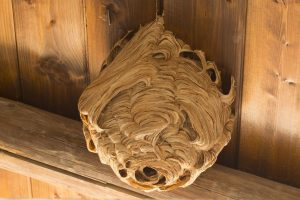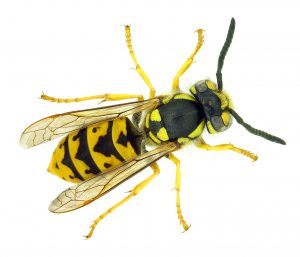One can easily get attracted to the membranous wings of these tiny wasps.
But these attractive insects possess a protective tool i.e. STING which is so lethal that no one should have imagined its consequences!
Yes the sting is lethal and for proving the statement let’s go through the following evidence:
Wasp Bite Gives Man a Heart Attack
By Cari Nierenberg, Live Science Contributor | September 22, 2017, 03:18 pm ET
A sting from a yellow jacket is typically a minor annoyance, but a wasp bite turned into a major medical problem for a 45-year-old British man:
In this man’s case, he was stung by a yellow jacket on his left arm as he got into his van. Minutes later, he began to feel dizzy and itchy all over, and a rash appeared on his body, according to the case report.
The man’s left hand began to feel heavy and achy, and hours later, this pain became more frequent and spread to his left arm, shoulder, and back. He called for an ambulance, and on the ride to the hospital, he suffered a heart attack, the case report said.
Wasp stings responsible for three deaths in Manitoba
By: Alexandra Paul, Winnipeg Free Press, Posted: 09/7/2017 11:41 AM
The city’s former entomologist is urging Winnipeggers to take precautions after three Manitobans died this summer after being stung by wasps.
The three deaths, including at least one in Winnipeg, were rare, said Taz Stuart, now the entomologist and director of technical operations at Poulin’s Pest Control.
The Chief Medical Examiner’s Office released data Thursday detailing deaths from any kind of bee, hornet or wasp. There have only been a handful of similar reports in the last 15 years.
By knowing the consequences we can think how deadliest it can be if one gets attacked by these yellowjackets!!
Firstly before we see what are the preventive measures to be taken against the sting of these tiny insects let’s get introduced to them.
WASPS with zoological name Vespula germanica are also commonly known as yellowjackets and hornets. Wasps vary tremendously depending on species. Most have two pairs of wings and a cinched waist. They range in colors from black to metallic greens and blues and vary in size from almost microscopic to several centimeters long. Wasps are a successful and diverse group of insects with tens of thousands of described species; wasps have spread to all parts of the world except for the Polar Regions.
 They are categorized as social or solitary. Social wasps live in colonies consisting of hundreds or thousands of more-or-less sterile female workers and their much larger mother, the egg-laying queen. The colonies are set up in a nest built by the wasp workers. The nests are constructed from wood fibers collected and then mixed with water. The nests are very strong and long-lasting structures.
They are categorized as social or solitary. Social wasps live in colonies consisting of hundreds or thousands of more-or-less sterile female workers and their much larger mother, the egg-laying queen. The colonies are set up in a nest built by the wasp workers. The nests are constructed from wood fibers collected and then mixed with water. The nests are very strong and long-lasting structures.
 Some wasps are predatory, while others are parasitic. Predatory wasps kill and consume other insects as well as other animals which they often feed to their larvae. Parasitic wasps typically lay their eggs in the bodies of living creatures like caterpillars or spiders. The larvae feed on the still-living host. Wasps can assist in the management of other pests, particularly in agriculture as biological control agents. Many wasps also feed on nectar from flowers and therefore function as pollinators. Wasps play a variety of roles in the environments such as pollinators, parasitoids, parasites, predators etc. Wasps are also just important in the environment. Social wasps being predators play a vital ecological role, controlling the numbers of potential pests like greenfly and many caterpillars.
Some wasps are predatory, while others are parasitic. Predatory wasps kill and consume other insects as well as other animals which they often feed to their larvae. Parasitic wasps typically lay their eggs in the bodies of living creatures like caterpillars or spiders. The larvae feed on the still-living host. Wasps can assist in the management of other pests, particularly in agriculture as biological control agents. Many wasps also feed on nectar from flowers and therefore function as pollinators. Wasps play a variety of roles in the environments such as pollinators, parasitoids, parasites, predators etc. Wasps are also just important in the environment. Social wasps being predators play a vital ecological role, controlling the numbers of potential pests like greenfly and many caterpillars.
Though wasps are important for the environment they are considered as pests and voracious species. People often get stung in summer when the wasp colonies stop breeding new workers. The workers then go in search of food and then come in contact with humans. If a human gets stung by a wasp, he can suffer pain and may also suffer from life-threatening anaphylactic shock.
Hence to prevent these deadliest stingy wasps get an eco-friendly solution provided by C Tech Corporation.
Combirepel™is an extremely low toxic, non-hazardous, non-mutagenic and non-carcinogenic anti-insect aversive.
Combirepel™ is developed on green technology and chemistry. It is effective against a broad spectrum of insects such as wasps, whiteflies, termites, beetles etc.
Our product works on the mechanism of repellency. It temporarily inhibits the mating cycle of the insects. The product impairs the ability of the insects to reproduce, that is the insects will not lay eggs or the laid eggs will be infertile. The product causes feeding disruption in an insect by triggering an unpleasant reaction within the insect which might try to feed on the application. The product temporarily blocks the reproduction system of the insects by hindering the release of the vital hormones for growth.
Combirepel™ is available in the form of the masterbatch, liquid concentrate, and lacquer.
Masterbatch can be incorporated into polymers while processing them. Cables, pipes, agricultural films, mulches, irrigation pipes etc. can be manufactured using masterbatch.
The liquid concentrate is to be mixed with paints in a proper ratio and can be applied on the interior and exterior of houses, schools, hospitals, warehouses, etc. to keep the wasps out of these places.
While lacquer is a direct topical application which can be applied directly to the already installed applications like cables, pipes, metal decors, furniture, wooden articles etc. Since the wasps build the nest in the areas like roof spaces, plywood built spaces, eaves, ceilings etc. places we need to repel them from such places.
Hence to repel them we C Tech Corporation suggest you apply our product Combirepel™. Our lacquer form product can be applied on wooden applications to which the wasps are attracted the most.
Combirepel™ is the best protection against the aggressive and voracious wasps.
Contact us at technical.marketing@ctechcorporation.com to keep the pests away.
Also, visit our websites:
http://www.ctechcorporation.com/
http://www.rodrepel.com/
http://www.termirepel.com/
http://www.combirepel.com/
Follow our Facebook pages at:
1] https://www.facebook.com/Combirepel-411710912249274/
2] https://www.facebook.com/Termirepel-104225413091251/
3] https://www.facebook.com/Rodrepel-120734974768048/
Follow us on our Twitter pages at:
1] https://twitter.com/rodrepel
2] https://twitter.com/termirepel
3] https://twitter.com/combirepel

